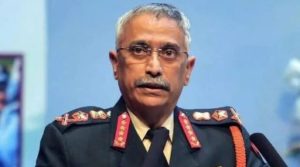
The Indian Army wanted 75 per cent of personnel recruited under the new scheme – Agnipath – to be retained, former army chief Gen MM Naravane writes in his upcoming memoir – ‘Four Stars of Destiny’.
Naravane, who served as army chief from December 2019 to April 2022, has in his new book shared insights about some of the key factors like service tenure, salary, and retention under the new scheme.
The Ministry of Defence rolled out the Agnipath scheme in June 2022 to “enable a youthful profile of the Armed Forces”. Under the scheme, youth are recruited for four years with a starting salary of Rs 30,000. After four years, 25 per cent personnel will be retained for the regular cadre while 75 per cent will be released.
In his book, which will hit the stand next month, Naravane says the first year’s starting salary for the new inductees was kept at just Rs 20,000 per month (all-inclusive) and that was “not acceptable”.
“This was just not acceptable,” the former army chief writes as per news agency PTI. “Here, we were talking about a trained soldier, who was expected to lay down his life for the country. Surely a soldier could not be compared with a daily wage labourer?”
Naravane adds that based on the army’s “very strong” recommendations, this was later raised to Rs 30,000 per month. Under the scheme, the personnel will get Rs 30,000 in the first year, Rs 33,000 in the second year, Rs 36,500 in the third year, and Rs 40,000 in the fourth year. The scheme sparked massive protests across the nation as the short duration of the service with no surety of retention did not go down well with the aspirants.
The former army chief reveals that all three forces were taken by surprise by the new formulation of the scheme. He writes that the army was “taken by surprise by this turn of events, but for the Navy and Air Force, it came like a bolt from the blue.”
“When I had first sounded out the PM about the Tour of Duty scheme, it was more on the lines of a short-service option at the soldier level, similar to the Short Service Commission scheme for officers that was already in vogue. Just as a limited number of SSC officers are taken each year, likewise a limited number of jawans would be similarly enrolled and released after the completion of their ‘tour’ with the option of re-enlisting for another tour, if found to be fit,” he writes.
The General further writes that nothing much happened in the next couple of months due to Covid and the clashes in Galwan in Ladakh. However, he writes, the prime minister’s office was considering this proposal, but with a much wider scope and applicability. “In the PMO formulation, not only should the complete intake of the year be short-service based, but it would also apply to all three services.”
Naravane writes having become a tri-service matter, it now fell on the CDS Gen Bipin Rawat to take the proposal forward, albeit with the army remaining the lead service. He says it took him some time to explain to the other chiefs that his proposal had only been army-centric. “And it took them some time to reconcile with the fact that they were very much part of the new proposal, dubbed the ‘Agnipath’ scheme by the PMO, with the soldiers, sailors and airmen recruited under this scheme to be known as ‘Agniveers’,” he notes.
On the preliminary discussions on ‘Agnipath’, Naravane writes the first issue to be addressed was that of retention and the army felt that it should be 75 per cent retention, while the Department of Military Affairs favoured that it should be 50-50 per cent with a five-year term.
The army veteran says this was the model that was presented by the CDS to a full panel comprising “the prime minister, ministers of home, defence and finance, the NSA, service chiefs, PS to the PM and the secretaries of the relevant departments in November 2020.”
“It was during this meeting that the terms ‘Agnipath’ and ‘Agniveer’ were used for the first time. Assuming an intake of 50,000 soldiers each year, then after each ‘tour’, 25,000 soldiers would revert to civil society,” he writes.
Naravane writes that it was felt that this was too little to bring about any significant change in the population since “one of the aims of the scheme was to give back to society disciplined manpower, who would be in a position to contribute much more in the workplace due to the values and ethos they would have imbibed while in service”.
The percentages therefore got reversed, with only 25 per cent to be retained and 75 per cent released, he writes. He says it was taken for granted that this would be like the SSC scheme, with the retention or release after the contracted period of five years. “On this account, the PMO view was that there should be a two-step retention process; 50 per cent after three years and another 25 per cent after five years, effectively making it only 25 per cent retention,” he says.
Naravane writes that this was just not practical as six to eight months would go into basic training and deployment, and the process for the selection of personnel to be released would also take about six months, meaning that any given jawan would be effective for just about two years. He says the discussions went on for some time. “Ultimately, a middle path was agreed upon, a one-step retention after four years of service.




 Driving Naari Programme launched in Chandigarh
Driving Naari Programme launched in Chandigarh






























